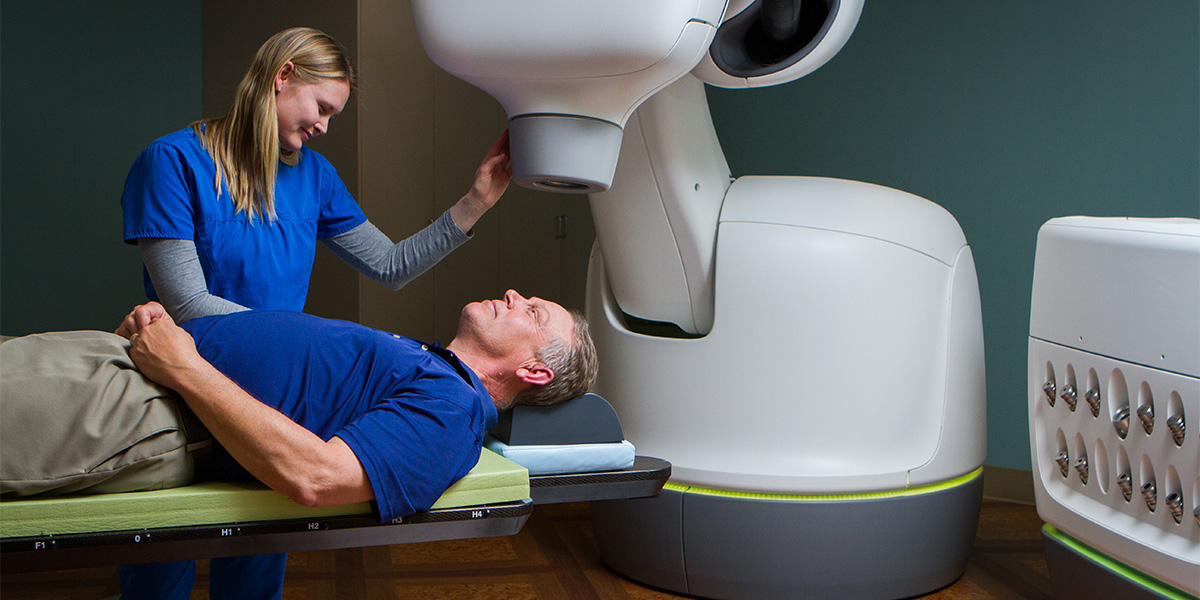
New technology improves safety of radiation therapy
Prostate is second only to skin cancer as the most frequently diagnosed cancer in men. Radiation therapy is among the most effective and common forms of treatment for prostate cancer. But radiation therapy for prostate cancer can sometimes result in undesirable side effects due to the proximity to other delicate tissues.
Now, a new technology at Gibbs Cancer Center & Research Institute protects prostate cancer patients from the potential adverse effects of radiation therapy including diarrhea, inability to control bowel movements and rectal bleeding.
Gibbs is one of the first cancer centers in the United States to use a new tool called the SpaceOAR® System, the first FDA-approved method for placing a ‘spacer' to protect the rectum of men undergoing prostate cancer radiotherapy. SpaceOAR painlessly and temporarily moves the prostate away from the rectum, allowing delivery of radiation to the prostate while reducing the dose to the rectal area.
Daniel B. Fried, MD, PhD, medical director and radiation oncologist at Gibbs Cancer Center & Research Institute—Pelham in Greer, S.C., is the first trained and certified radiation oncologist to use SpaceOAR in the Carolinas.
Dr. Fried is also the first trained and certified radiation oncologist in the United States to combine SpaceOAR technology with the CyberKnife M6 Robotic Radiosurgery System for the treatment of low-risk, and favorable intermediate risk, prostate cancer patients. Currently, Dr. Fried is one of the top 10 SpaceOAR providers in the U.S.
"Rectal radiation exposure limits our ability to deliver high doses of radiation to the prostate,” Fried said. “The SpaceOAR System substantially reduces that obstacle, allowing us to deliver higher doses of radiation to more safely and effectively treat the cancer.”
SpaceOAR consists of a water-based hydrogel administered by a physician in a simple procedure. The gel is injected through a needle into the body as a liquid and quickly solidifies into a soft gel that expands the space between the prostate and rectum. The hydrogel spacer maintains this separation until radiotherapy is complete. The spacer then liquefies and is absorbed and eliminated from the body in the patient's urine. Most patients report that they have little or no discomfort from the procedure.
The accuracy, power and flexibility of the robotic CyberKnife M6 offers patients more advanced treatment options versus conventional radiation methods. CyberKnife treats organ-confined prostate cancer in just five radiation sessions, compared to an average of 43 sessions with conventional radiation. Most patients report few side effects after CyberKnife therapy, and say they are able continue their normal daily activities throughout the course of treatment.
Combining the cutting-edge SpaceOAR and CyberKnife technologies can give prostate cancer patients faster, safer and more accurate radiation therapy.
The Gibbs Radiation Oncology center in Greer isn't just the only clinic in the Carolinas currently providing this powerful combination – it has the first trained and certified physicians in the United States to combine CyberKnife and SpaceOAR.
“This exciting innovation in prostate cancer therapy is a vivid illustration that Gibbs continues to bring the most advanced and personalized cancer treatments to our patients at home, and throughout the Southeast,” Fried said. “This is another example of the highly advanced treatments we bring to our patients. We aren't just the first in the Upstate, but we are the first trained and certified facility in the entire United States to combine CyberKnife and SpaceOAR.”
For more information, call 1-855-DNA-GIBBS.










